It was a beautiful day in Hawai'i and I got up nice and early to ready for my first trip to the Lo'i (taro patch). We drove further out into the countryside, and up a narrow road into the valley. Finally we came to a point in the road where we pulled off to the side and parked. We pulled out our packs full of supplies for the day s adventure, and then got the o'o (stick used for digging) out from the back of the truck. We crossed the road and stepped onto the path. Then we heard voices coming out of the forest, so we awaited their arrival, as the trail was only wide enough for one-way traffic. It was a group of elementary school students who had just come from their excursion to the Lo'i. Once they were all gathered at the entrance to the path, the leader stopped and then began asking the students what they had observed and learned from their trip. We left and began our trip to the site.
The pathway was winding, up and down hills, across streambeds of flowing waters, and muddy. The growth along the way was lush and green. The well-worn path was muddy from the rains, so in places it was very slippery and this was when the o'o came in very handy indeed for steadying our steps. Once the path opened up onto a dirt road, there was a pipe that ran along the way, bringing fresh water up from the farm below.
A short way down the road we came to a clearing where there were two makeshift structures built from trees and metal corrugated panels for roofs. Between the two buildings was a chalkboard where a listing of all the chores that needed to be done was written. One structure was where the tools were all stored and the other was where a table, a bulletin board, and some other supplies were kept. I later found that the second structure was basically used as a meeting place for the group and where they set out the meal to be eaten later in the day after working the Lo'i.
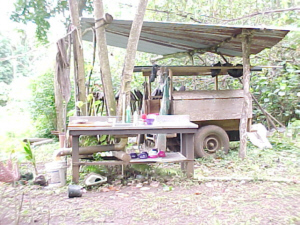  © ©
Tool Shed and Eating Shed
The group straggled in throughout the morning after they had all been to another site doing some volunteer clean up work--something they apparently do on a regular basis. As people arrived, they found their way to different areas of the Lo'i and began doing chores that needed attention. One couple went across to the far side of the Lo'i and began cutting up wood to be laid down to create a more stable and drier pathway between the taro patches.
Two others went back into the forest to get some wood for another project. When they returned, they began to make rafts for the growing of Leko (watercress). During the clean up down at the other site, some netting that had been trashed was salvaged in the hopes of being used for something at the Lo'i. It was perfect for the creation of the center base of the rafts. Once the rafts had been crafted from the tree limb, netting, and twine, some wild watercress was gathered and wound into the netting for stability. Then the rafts were secured to the bridge, so the flowing waters of the stream wouldn't wash them away. Further along the stream the first rafts created for this purpose had been secured to a makeshift arbor that spanned the stream.
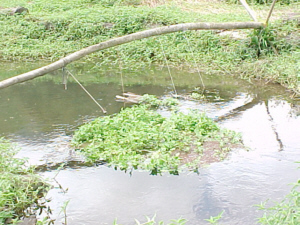 © ©
Watercress Floats
I mentioned before that as others arrived, they each went about doing whatever chores they decided to tackle first. One of the earlier arrivals set to starting the fire in the pit for the stone soup that would be made for lunch. Then he went into the vegetable garden area and began harvesting some fresh vegetables to be added to the pot for the soup along with the other ingredients that had been brought. Some of the group are farmers, so they brought things they grow to be added while others brought fruit, po'ke, spam sushi, sardines, avocado, crackers, bread, cookies, and a few other munchies. And then there was a large cooler of fresh cold water. Once lunch was ready and most of the group had gathered at the Lo'i, we all grazed on lunch. The soup was still cooking, so it was to be eaten later.
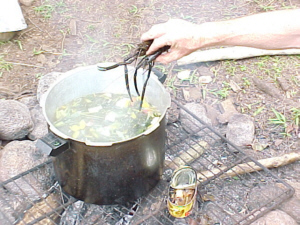 © ©
Stone Soup w/Prawn
While we ate, and for a bit after we d finished, everyone milled about chatting on all manner of topics or as we say, talk story . Then, everyone went back to work. I went into the tool shed and got a shovel to help with the fertilization of the taro patches. The guys put three bags of kukai moa (chicken manure) along either bank of one of the patches to be spread in each half of the patch. For a while another lady and I pitched shovels full of the substance across the surface of the patch until the wind kept changing directions, blowing the dust back at us. That was when we decided that we d take the remaining bags of the stuff into the patch and spread it directly. There were times that in the swinging about of the bag almost caused me to lose my balance to the point of falling into the water and deep mud of the patch. And flinging the mixture about from the bags did not stop the wind from occasionally blowing it back at us still.
Once we were done with the fertilization, we gathered up the tools into the wheelbarrow we d been using and then entered one of the other patches to do some weeding. All throughout the day the rains would come and go as quickly as they d arrived. So, finally we were done with the weeding process. Next there were seeds that needed planting, so a few of us set about selecting sites for the plantings and got to work. Another took a sapling and put it into the ground. Yet another took the chainsaw and began cleaning out more of the brush and fallen trees along the edge of one of the patches.
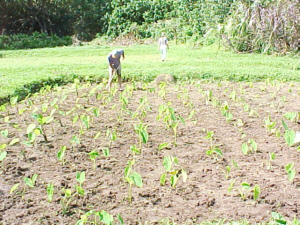 © ©
Weeding Dry Kalo Patch
Then a few of the group members went to one of the older patches that they were using for harvest to get their week s supply of taro for home. This patch was a Tahitian variety that has a tendency to spoil rapidly if not picked as soon as it has matured. My companion and I eventually made our way over to the patch to get our harvest from the day.
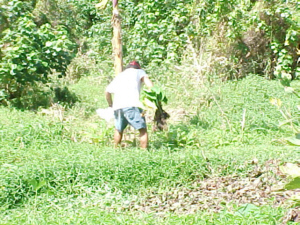 © ©
Picked Kalo




|
 ©
© ©
©
 ©
©
 ©
©
 ©
©
 ©
©
 ©
©


